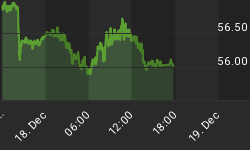
Dollar willing, one scenario that appears ever more likely to gain traction over the coming weeks is a break in the macro commodity trade. And while it is a key ingredient to my longer term bullish perspective towards equities, it will likely have an intermediate term disruptive effect to market equilibrium and liquidity.
As everyone is well aware of by now, the hot money sector over the past ten years has been in commodities. Just last month commodities beat stocks, bonds and the dollar for a fifth straight month - the longest such stretch in the last 14 years.
"Commodity investments stood at $376 billion as of Dec. 31, 2010, up from $270 billion the year before, helped by net inflows of $62 billion, the report said. While those net inflows were down from a record $72 billion the year before, institutional investors accounted for an ever-greater portion of the total as the year progressed -- with a record $8 billion in December alone, according to the report. For the year, Barclays' analysts estimated net institutional inflows of almost $46 billion, or almost three quarters of the total inflows.
"The return of the institutional investor, massive inflows into precious metals led by the desire to hedge against financial market risk, and the gradual shift towards active management of commodity strategies were among the key stories of the year," the Barclays report said." Pensions & Investments
(Reuters) - "Commodity funds drew the most new cash among nine tracked sectors in the fourth week of April as investors sought to counter effects of a weaker dollar and rising inflation, EPFR Global said on Friday.
Commodities funds took in $961 million in the week, putting them on track to exceed the record $32 billion of 2010, said EPFR, which tracks fund flows."
What is worth noting here is not just the magnitude of inflows - but the ever growing participation by institutions. While many traders would find a greater institutional participation as favorable to market conditions, I would strongly disagree with that logic. Institutional managers during market extremes are rarely doing what they personally would advocate. Because of the infusions of new money during rallies and redemptions during crashes, they are forced to invest or liquidate against their own best judgment.
In a sense they create the monster that eventually takes down the house.
Look no further than the institutional participation during the melt-up in equities in 2007. The retail investor/trader was basically a nonparticipant (net inflows), yet the market eventually collapsed upon the weight of the institutions.
It is why trading is often counter intuitive to the obvious perspective of the financial media.
Babak, over at Trader's Narrative has a nice footnote to this story, specifically addressing Jeremy Grantham's latest musings on commodities:
"My objection was that at or near the top of every single major market move, we can find intelligent people who argue that we have said goodbye to the usual cycles of the past and are now embarking on a new period of linearity. If you were around the last equity market top in 1999 and 2000 you won't have to strain hard to remember the arguments. Who could forget "Dow 36,000"?
Casting back a few more years to the infamous 1920 equity market bubble, we have the infamous words of Yale economist Irving Fisher, who said days before the crash, "Stock prices have reached what looks like a permanently high plateau." And I'm sure you won't have any difficulty in coming up with more examples.
While we may scoff at these past arguments with the perfect knowledge that hindsight provides us, at the time they were intelligently sourced and convinced many.
So that provides the biggest caveat emptor whenever we hear the words "it is different this time" or any variations thereof." April 28, 2011
Positions in ZSL, UUP and TWM
















